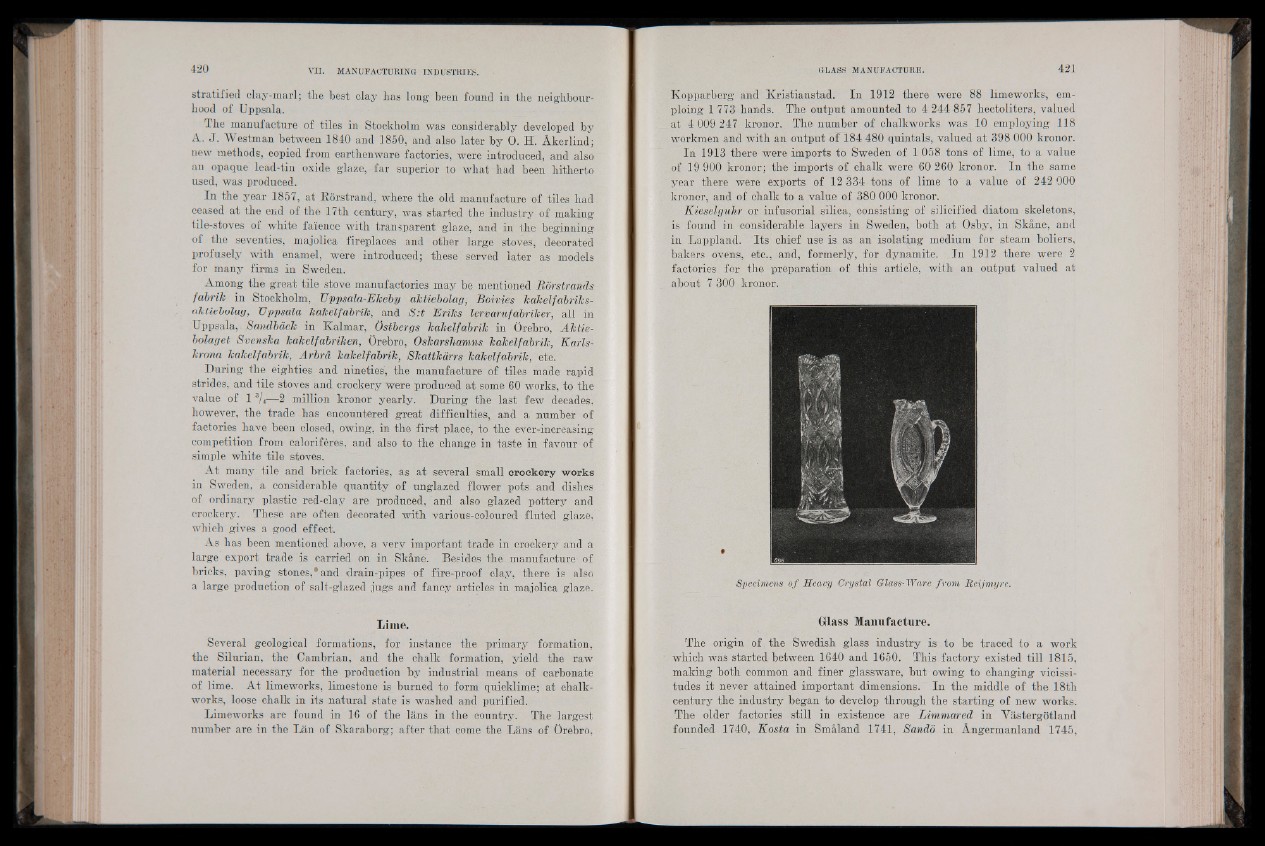
stratified clay-marl; tlie best clay bas long been found in the neighbourhood
of Uppsala.
The manufacture of tiles in Stockholm was considerably developed by
A. J. Westman between 1840 and 1850, and also later by 0 . H. Akerlind;
new methods, copied from earthenware factories, were introduced, and also
an opaque leaid-tin oxide glaze, far superior to what had been hitherto
used, was produced.
In the year 1857, at Kôrstrand, where the old manufacture of tiles had
ceased at the end of the 17th century, was started the industry of making
tile-stoves of white faïence with transparent glaze, and in the beginning
of the seventies, majolica fireplaces and other large stoves, decorated
profusely with enamel, were introduced; these served later as models
for many firms in Sweden.
Among the groat tile stove manufactories may be mentioned Rbrstrands
fabrik in Stockholm, TJppsala-Ekeby aktiebolag, Boivies kakelfabriks-
aktiebolag, Uppsala kakelfabrik, and S :t Eriks lervarufabriker, all in
Uppsala, Sandbâck in Ealmar, Ostbergs kakelfabrik in Orebro, Aktie-
bolaget Svenska kakelfabriken, Orebro, Oskarshamns kakelfabrik, Karls-
krona kakelfabrik, Arbrâ kakelfabrik, Skattkarrs kakelfabrik, etc.
During the eighties and nineties, the manufacture of tiles made rapid
strides, and tile stoves and crockery were produced at some 60 works, to the
value of 1 3li—2 million kronor yearly. During the last few decades,
however, the trade has encountered great difficulties, and a number of
factories have been closed, owing, in the first place, to the ever-increasing
competition from calorifères, and also to the change in taste in favour of
simple white tile stoves.
At many tile and brick factories, as at several small crockery works
in Sweden, a considerable quantity of unglazed flower pots and dishes
of ordinary plastic red-clay are produced, and also glazed pottery and
crockery. These are often decorated with various-coloured fluted glaze,
which gives a good effect.
As has been mentioned above, a very important trade in crockery and a
large export trade is carried on in Skânëï Besides the manufacture of
bricks, paving stones,* and drain-pipes of fire-proof clay, there is also
a large production of salt-glazed jugs and fancy articles in majolica glaze.
Lime.
Several geological formations, for instance the primary formation,
the Silurian, the Cambrian, and the chalk formation, yield the raw
material necessary for the production by industrial means of carbonate
of lime. At limeworks, limestone is burned to form quicklime; at chalk -
works, loose chalk in its natural state is washed and purified.
Limeworks are found in 16 of the Ians in the country. The largest
number are in the Lan of Skaraborg; after that come the Lans of Orebro,
ICopparberg and Kristianstad. In 1912 there were 88 limeworks, em-
ploing 1 773 hands. The output amounted to 4 244 857 hectoliters, valued
at 4 009 247 kronor. The number of chalkworks was 10 employing 118
workmen and with an output of 184 480 quintals, valued at 398 000 kronor.
In 1913 there were imports to Sweden of 1 058 tons of lime, to a value
of 19 900 kronor; the imports of chalk were 60 260 kronor. In the same
year there were exports of 12 334 tons of lime to a value of 242 000
kronor, and of chalk to a value of 380 000 kronor.
Kieselguhr or infusorial silica, consisting of silicified diatom skeletons,
is found in considerable layers in Sweden, both at Osby, in Skane, and
in Lappland. Its chief use is as an isolating medium for steam boliers,
bakers ovens, etc., and, formerly, for dynamite. In 1912 there were 2
factories for the preparation of this article, with an output valued at
about 7 300 kronor.
Specimens o f Heavy Crystal Class-Ware from Reijmyre.
Class Manufacture.
The origin of the Swedish glass industry is to be traced to a work
which was started between 1640 and 1650. This factory existed till 1815,
making both common and finer glassware, but owing to changing vicissitudes
it never attained important dimensions. In the middle of the 18th
century the industry began to develop through the starting of new works.
The older factories still in existence are Limmared in Vastergôtland
founded 1740, Kosta in Smâland 1741, Sando in Angermanland 1745,